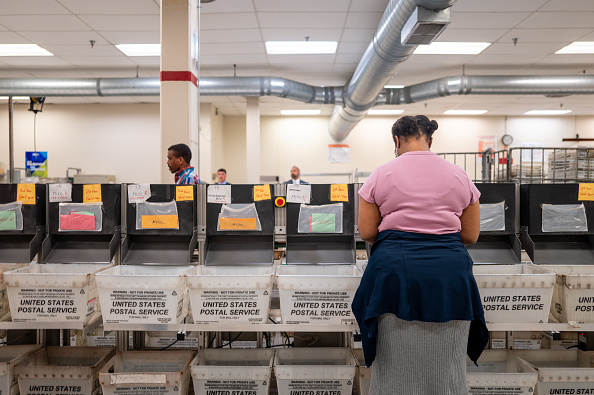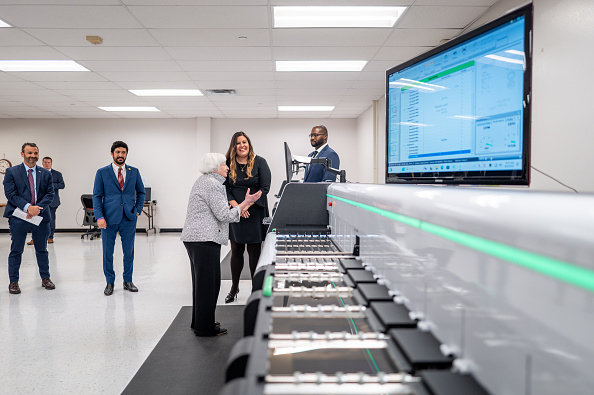Inside the IRS push for digital transformation

Treasury Secretary Janet Yellen speaks to reporters on a tour of a tax processing facility in Austin, Texas. Brandon Bell/Getty Images
IRS employees at an Austin, Texas processing center must still sort through heaps of paper documents. But digitization tools are being powered on to help.
AUSTIN, Texas — Minutes from downtown Austin, Texas, off a series of highways, sits a 1960s-era IRS processing center.
Inside, noisy mail sorters spit envelopes into lines of bins. Employees sit under fluorescent lights and manually inspect paper tax returns for flaws. Others stamp piles of paper with identifying numbers.
Some physically type returns into computers, and around another corner, their colleagues use computers with black screens lined with neon green text to fix errors, a setup likely foreign the average laptop user.
The processing of paper at the IRS in Austin hasn’t changed much in decades, but the IRS is trying to transform operations using the billions Congress gave the agency through the Inflation Reduction Act.
“New equipment, new potential,” read blue and green posters on the walls above new scanning machines. “Investing in you, delivering for the taxpayers.”
It’s been just over two years since Congress passed the IRA, which sent about $80 billion to the tax agency after years of decreasing funding, although lawmakers chipped away about $20 billion of that funding as part of a debt ceiling deal with the White House last year.
Continued funding is critical to move the agency into the 21st century, IRS Commissioner Danny Werfel and Treasury Secretary Janet Yellen told reporters on a Friday tour of the facility.
“This work will enable all taxpayers to complete all interactions with the IRS digitally, if they choose,” Werfel said, calling the endeavor a “generational imperative.”
Although most people file their taxes online, the IRS still gets around 76 million paper returns annually, in addition to millions more pieces of correspondence from taxpayers to fix errors, provide requested information and more.
So far, the Austin processing site — one of three at the IRS, each with thousands of employees — invested in new mail sorting machines earlier this year to replace decades-old ones.

Down the hall, scanning machines were installed this year. They’re meant to reduce the amount of physical document work at the IRS by converting paper into a digital format.
The new scanners in Austin are still being configured to correctly extract the data from the paper returns, according to an IRS official, meaning that people still have to manually type the paper returns coming into that facility into computers.
Last summer, the IRS launched a “paperless processing initiative,” with the goal of digitizing all paper returns when received by filing season 2025.
That will upend the current way paper snakes its way through the facility. Although the feds that process paper now will need to be re-trained, they won’t be displaced, Doreen Greenwald, president of the National Treasury Employees Union, said during remarks on Friday, noting that “employees will be needed more than ever.”
In a complementary push, the IRS is working to give taxpayers a way to respond to agency asks without sending in paper at all. Americans have used an agency tool to upload photos or scans of certain documents online for 1 million digital document submissions so far, Werfel said.
But the effort to digitize Americans’ interactions with the IRS also requires the agency to overhaul its foundational technology. The individual tax return data that people type into computers in Austin feeds a core, back-end system at the IRS called the Individual Master File.
Like the Austin building, the IMF dates to the 1960s, and the IRS has been trying to modernize it for at least 15 years. The agency has updated the system's hardware and translated the code into a modern language, but still uses the old processing engine.
The IRS has been running a new processing engine in parallel with the legacy system this year to test the new solution, although Werfel told Nextgov/FCW last week that it will stick with the legacy system for another filing season.
If the IRS were to attempt to go to the new IMF system and stumble, the failure would have ripple effects on other big modernization efforts — one reason the agency is taking a more cautious approach, he said.
In the course of these different modernization efforts, oversight officials have written in multiple reports arguing that there isn’t enough detailed planning at the IRS.
“I wouldn’t read into the lack of specificity as having no plan,” Werfel told Nextgov/FCW, noting that the watchdog reports aren’t surprising given the level of complexity in IRS technology.
“I also wouldn’t say that every single I is dotted and T is crossed,” he continued. “We have, I would say, high precision in IMF, growing precision in [the Business Master File], and probably in enterprise case management we are the least mature, but are getting there.”
The procession through the IRS building ended in the cafeteria, a location that served as storage for paper backlogs during the pandemic, making headlines in the Washington Post. At the end of 2021, for example, the IRS had a backlog of 10.5 million paper returns.

“The Austin cafeteria is symbolic of where we were prior to the Inflation Reduction Act and where we are today,” said Werfel. “The funding we received… allowed us to dig out of a deep hole.”
Congress is currently working on appropriations for the upcoming fiscal year, which starts in October. The IRS has asked lawmakers to sustain IRA funding through fiscal year 2034 for $104 billion total.
House Republicans, meanwhile, have proposed budget cuts for the tax agency, in addition to defunding its new, online tax filing product, Direct File, which was borne out of the law and its funding.
“Even as we make progress, we continue to face challenges from those in Congress who want to cut the funding that’s enabling it,” said Yellen. “And I’ll just say, this would be disastrous.”
Cuts “could make it easier for wealthy Americans and corporations to avoid paying what they owe, while working Americans foot the bill. It could leave American households and businesses without the support they deserve,” Yellen said. “And it could contribute to increasing our country’s deficit.”
In terms of technology, 2025 IRS budget documents note that the IRA money funneled into the tech-focused Business Systems Modernization account — which lawmakers zeroed out in 2023 and 2024 annual appropriations — isn’t enough to fund all of the planned activities for IRS tech through 2031. That means the tax agency will need to dip into its operations support bucket of money, which itself is already running at an annual discretionary shortfall.
In addition to the tech upgrades, some of the updates have been more basic. An announcement from Greenwald that new chairs were on the way received the most applause from the audience of IRS employees.






